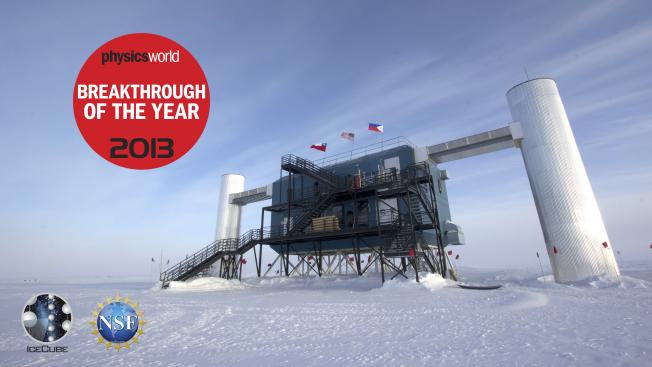Measurement of the Atmospheric $ν_e$ flux in IceCube
ArXiv 1212.476 (2012)
Abstract:
We report the first measurement of the atmospheric electron neutrino flux in the energy range between approximately 80 GeV and 6 TeV, using data recorded during the first year of operation of IceCube's DeepCore low energy extension. Techniques to identify neutrinos interacting within the DeepCore volume and veto muons originating outside the detector are demonstrated. A sample of 1029 events is observed in 281 days of data, of which 496 $\pm$ 66(stat.) $\pm$ 88(syst.) are estimated to be cascade events, including both electron neutrino and neutral current events. The rest of the sample includes residual backgrounds due to atmospheric muons and charged current interactions of atmospheric muon neutrinos. The flux of the atmospheric electron neutrinos is consistent with models of atmospheric neutrinos in this energy range. This constitutes the first observation of electron neutrinos and neutral current interactions in a very large volume neutrino telescope optimized for the TeV energy range.Search for dark matter annihilations in the Sun with the 79-string IceCube detector
ArXiv 1212.4097 (2012)
Abstract:
We have performed a search for muon neutrinos from dark matter annihilation in the center of the Sun with the 79-string configuration of the IceCube neutrino telescope. For the first time, the DeepCore sub-array is included in the analysis, lowering the energy threshold and extending the search to the austral summer. The 317 days of data collected between June 2010 and May 2011 are consistent with the expected background from atmospheric muons and neutrinos. Upper limits are therefore set on the dark matter annihilation rate, with conversions to limits on spin-dependent and spin-independent WIMP-proton cross-sections for WIMP masses in the range 20 - 5000 GeV. These are the most stringent spin-dependent WIMP-proton cross-sections limits to date above 35 GeV.Results of a self-triggered prototype system for radio-detection of extensive air showers at the Pierre Auger Observatory
ArXiv 1211.0572 (2012)
Abstract:
We describe the experimental setup and the results of RAuger, a small radio-antenna array, consisting of three fully autonomous and self-triggered radio-detection stations, installed close to the center of the Surface Detector (SD) of the Pierre Auger Observatory in Argentina. The setup has been designed for the detection of the electric field strength of air showers initiated by ultra-high energy cosmic rays, without using an auxiliary trigger from another detection system. Installed in December 2006, RAuger was terminated in May 2010 after 65 registered coincidences with the SD. The sky map in local angular coordinates (i.e., zenith and azimuth angles) of these events reveals a strong azimuthal asymmetry which is in agreement with a mechanism dominated by a geomagnetic emission process. The correlation between the electric field and the energy of the primary cosmic ray is presented for the first time, in an energy range covering two orders of magnitude between 0.1 EeV and 10 EeV. It is demonstrated that this setup is relatively more sensitive to inclined showers, with respect to the SD. In addition to these results, which underline the potential of the radio-detection technique, important information about the general behavior of self-triggering radio-detection systems has been obtained. In particular, we will discuss radio self-triggering under varying local electric-field conditions.Search for Galactic PeV Gamma Rays with the IceCube Neutrino Observatory
ArXiv 1210.7992 (2012)
Abstract:
Gamma-ray induced air showers are notable for their lack of muons, compared to hadronic showers. Hence, air shower arrays with large underground muon detectors can select a sample greatly enriched in photon showers by rejecting showers containing muons. IceCube is sensitive to muons with energies above ~500 GeV at the surface, which provides an efficient veto system for hadronic air showers with energies above 1 PeV. One year of data from the 40-string IceCube configuration was used to perform a search for point sources and a Galactic diffuse signal. No sources were found, resulting in a 90% C.L. upper limit on the ratio of gamma rays to cosmic rays of 1.2 x 10^(-3)for the flux coming from the Galactic Plane region (-80 deg < l < -30 deg; -10 deg < b < 5 deg) in the energy range 1.2 - 6.0 PeV. In the same energy range, point source fluxes with E^(-2) spectra have been excluded at a level of (E/TeV)^2 d\Phi/dE ~ 10^(-12)-10^(-11) cm^2/s/TeV depending on source declination. The complete IceCube detector will have a better sensitivity, due to the larger detector size, improved reconstruction and vetoing techniques. Preliminary data from the nearly-final IceCube detector configuration has been used to estimate the 5 year sensitivity of the full detector. It is found to be more than an order of magnitude better, allowing the search for PeV extensions of known TeV gamma-ray emitters.Observation of Cosmic Ray Anisotropy with the IceTop Air Shower Array
ArXiv 1210.5278 (2012)



